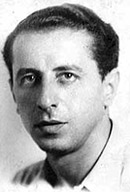In the Cage of Feeling

Last week marked the hundredth birthday of Natan Alterman, one of the greatest and most dramatic of modern Hebrew poets and, in another aspect of his persona, a compelling and strong-minded commentator on contemporary events.
Born in Warsaw in 1910, Alterman arrived in Tel Aviv at the age of fifteen. The modernism of the city, then as now a counterpoint to Jerusalem, made itself felt not only in its architecture but also in its literary life. There, in the 1920s, a circle of younger poets influenced by such European symbolists as Rainer Maria Rilke and Boris Pasternak was consciously seeking to move away from the regnant Hebrew model of naturalism and classicism set by Chaim Nahman Bialik. To this group, whose prime mover was Avraham Shlonsky (1900-1973), Alterman attached himself, as, later, did Leah Goldberg. Also leaving a mark on Alterman's early work were French followers of the Imagist school whom he would encounter when he spent time in Paris studying agronomy.
Alterman's first book, Kokhavim Bahutz ("The Stars Outside," 1938), was marked by dense vocabulary and enigmatic imagery; his father complained that he didn't understand a word of it. But the book established him as a powerfully individual voice and it contains some of his most enduringly beloved poems. A second book, Simhat Aniyim ("Pleasures of the Poor," 1941), often described as his greatest work, is a cycle of thirty-one poems narrated by a ghost who endlessly circles the beloved woman he has left behind among the living. Written under the darkening skies of the time, in language more elegant and accessible than its predecessor, it has struck many readers as an uncanny prophetic imagining of the destruction of Jewish life in Europe and its renewal in Zion. As Alterman's work progressed in Shirei Makot Mitzrayim ("Poems of the Plagues," 1944) and Ir Hayonah ("City of the Dove," 1957), his diction became simpler and the urgently implicit connections he was drawing between the Jewish past and his own time increasingly evident.
All along, Alterman had also been creating another body of poetic work, one that forthrightly expressed his views on public events. In 1934, the Labor Zionist newspaper Davar published a series of his whimsical, rhymed observations under the title "Tel Aviv Sketches." Later that year the feature moved to Haaretz; in 1943, he returned to Davar, where he went on writing his verse column, now titled Hatur Hashevi'i ("The Seventh Column") until 1967.
In its idiomatic register and its use of rhyming couplets to achieve prosaic effects, Alterman's "journalistic" verse seems deeply influenced by W.H. Auden. In these columns, the most famous of which is Magash Hakesef, "The Silver Platter," he recorded his vigorous response to the events of his times in a voice balancing unfeigned sincerity with satiric acerbity, and passionate personal commitment to the Zionist project with sharp questioning of specific practices and policies. The balance was hard to maintain.
Alterman's death in 1970 was followed seven years later by the death of his daughter, the gifted and troubled poet Tirza Atar. An early suicide attempt of hers had elicited a haunting paternal plea, Shimri Nafshekh ("Safeguard Your Soul"). Observing Alterman as he composed this poem with shaking hands, the novelist Yoram Kaniuk "thought about how he succeeds in inserting the commas and periods as his eyes are shedding tears. He built this drama within a cage of order." This same ability to impose exquisite form on raging feeling, both personal and collective, is a key to Alterman's lasting power.
Comments are closed for this article.




